
Features
Biocontrols
Inputs
Growing Points: Fighting fire with fire
January 22, 2014 By Dr. Mohyuddin Mirza
Integrated Pest Management (IPM) is a very common phrase used at workshops, conferences and other forums.
Integrated Pest Management (IPM) is a very common phrase used at workshops, conferences and other forums.
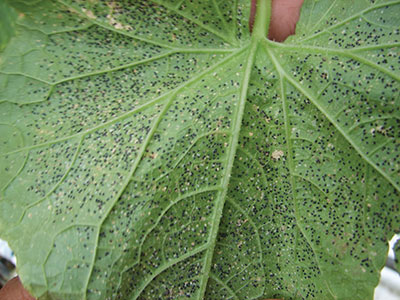
|
|
Last fall, we organized an IPM workshop at an Edmonton greenhouse and it attracted over 60 growers.
I feel that Ontario is at the forefront of the IPM movement. Many workshops have been conducted in the province with more on the way.
“Biocontrol” is a major IPM strategy. But IPM also involves monitoring; proper identification of the insects and understanding how best to control them; spot spraying; and the adoption of cultural practices to reduce damage caused by pests.
Another strategy is the use of pesticides, applied either as a preventive measure or after pests have been detected. I have noticed that many products are based on peroxides, peroxyacetic acids and dormant oils with claims of integrating well with pest management practices.
I was introduced to IPM in early 1980 when I was a rookie greenhouse specialist at the Alberta Horticultural and Special Crops Research Centre in Brooks, Alta.
I will never forget my introduction to IPM. Our team was working to introduce seedless cucumber crops into Alberta greenhouses, a switch from growing the more traditional varieties. We planted these Long English cucumbers (‘Corona’) and had planned an open house. We were especially happy and proud that we would be able to show growers how to grow, manage and harvest them!
A day before the open house, I walked into the greenhouse and started checking plants. I had heard that whitefly can be devastating to these plants and the problem usually starts under the leaves. Lo and behold, I turned a few leaves over and found very few areas where whiteflies were not present.
The use of yellow sticky traps to monitor for whiteflies by was not yet common at that time. There were no commercial suppliers of these traps.
However, I had heard of a possible solution that involved hanging yellow garbage bag plastic, coated with Vaseline, close to the plants. It was also suggested you could spray yellow rust paint on plastic to attract the insects.
I spread vaseline over some yellow plastic garbage bags and was wondering how to hang them close to the plants.
I had a “brilliant” idea. This is the first time this “unique” strategy is being revealed!
I made a hole in the Vaseline-coated yellow plastic bags and pushed my head through and wore them like a shirt. It provided a large surface area. I stood in the walkway and shook the plants and pretty soon a great number of whiteflies were stuck on the yellow plastic.
(Incidentally, I wore a facemask, otherwise I would have been choking on whiteflies.)
What if the workers who go through the rows carried a small sticky trap and checked them at the end of the row for the presence of whiteflies or thrips?
Over the years these traps have gotten smaller in size and are effective when placed at the recommended distances.
This was my introduction to IPM and I learned that a large number of whiteflies can be trapped and killed with yellow sticky traps. Incidentally, we had a great open house that year and showed growers how to get rid of whiteflies on cucumbers with the use of yellow sticky traps!
What started after this was quite interesting.
At that time, Applied Bio-nomics was getting started in British Columbia and I had the honour of meeting company founder Don Elliott. I invited him to meet growers and speak at our workshops and conferences. IPM in the province was off to a running start!
It always remained an “IPM” program, although we did use terms like “biocontrol” and “biological controls,” and some others. I clearly recall a project in which parasitic wasps (Encarsia formosa) were introduced on cucumber and tomato crops, and achieved very good parasitization. I believe they were raised on tobacco leaves at that time.
I don’t know when I took the picture on page 8, but I used to be so happy to see all those eggs of whiteflies being parasitized. Here is what a great biocontrol should look like! All those black spots are eggs of whiteflies parasitized by Encarsia.
The Applied Bio-nomics website has some very interesting historical information on greenhouse biological control. The following is an excerpt:
“Greenhouse biological control has a long history in Canada. The whitefly parasite Encarsia formosa was first obtained from the Cheshunt Experimental Station in England in 1935 and mass production was started by J.H. McLeod at the Dominion Parasite Laboratory in Ontario. McLeod shipped more than 18 million Encarsia parasites to Canadian greenhouse growers from 1938-1954. He reported that the parasites had been sent by railway and ship to Newfoundland as well as by rail to all provinces of the Dominion. Unfortunately, with the development of DDT and other new pesticides in the ’40s, the mass production of the parasites was all but discontinued by 1955.” (www.appliedbio-nomics.com/history-canadian-greenhouse-biological-control/)
The rest of the article is equally informative. Take time to read it so that you know where we are now and how we got here.
I am going to focus on the monitoring of insects for use in developing IPM strategies.
MONITORING IS THE FIRST STEP IN IPM
Vegetable growers were the first to adopt IPM practices and the use of biological controls is one of the strategies. I have seen large numbers of these yellow sticky tapes or traps used as a means of reducing the populations of whiteflies and thrips. These can stay in the crop longer than the smaller ones that are strictly used for monitoring on a weekly basis.
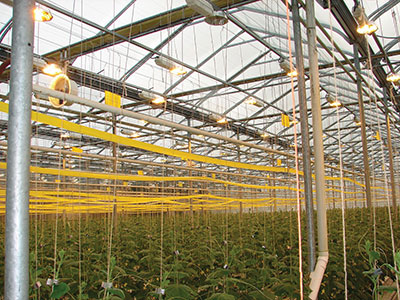
|
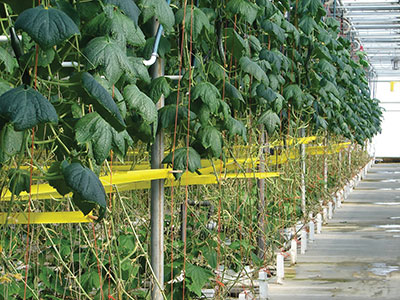
|
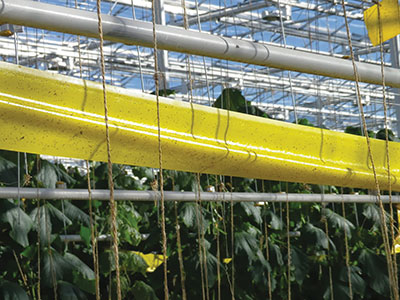 |
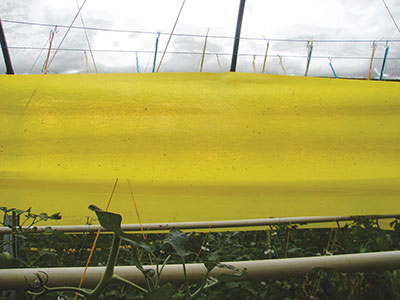
|
These four pictures provide a practical example of how cucumber and tomato growers use yellow sticky traps for actually reducing the populations of whiteflies and thrips, two major pests of cucumbers. Some of these examples would have provided more surface area without the wrinkles!
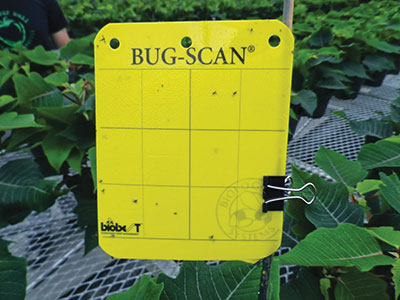 |
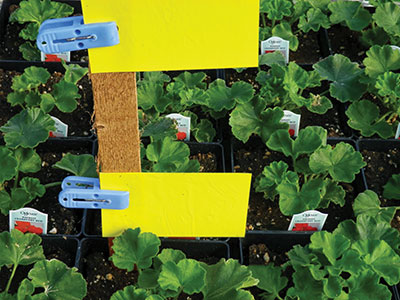
|
These are examples of yellow sticky traps being used for monitoring bedding plants and ornamental crops. They generally trap more fungus gnats and shoreflies, followed by thrips.
A CLOSER LOOK AT THE TRAPS
A simple hand lens is the starting point. I like the one that can be worn on your head. I have seen some very nice options for hand lenses. I have one with 15x magnification and an LED flash. Just be careful because these yellow traps are sticky and can get stuck to your fingers and clothes.
I have seen growers use these sticky traps in many different ways.
What happens if you get too busy and don’t monitor the traps? I can share many stories where these traps were not properly monitored and it resulted in a significant loss of produce.
Western flower thrips are difficult to control if the populations increase beyond a “threshold” point. That is when these sticky traps should be monitored and recorded regularly.
I know many growers who record the number of insects trapped every week. In this way they can measure the success of their IPM practices as well. I have found these records very useful for bedding plant plug growers when customers may notice a few insects. They want to know what IPM practices have been followed.
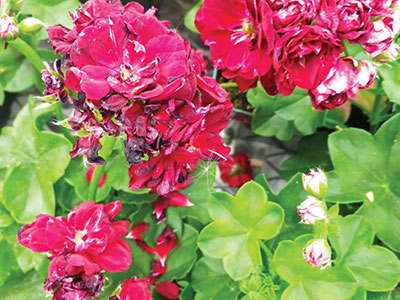
|
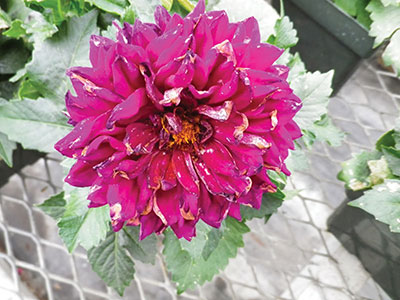
|
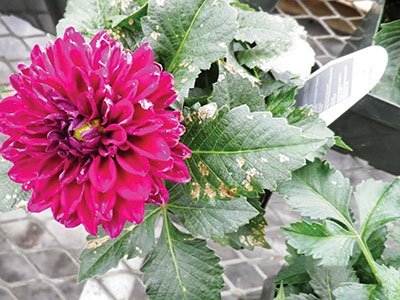
|
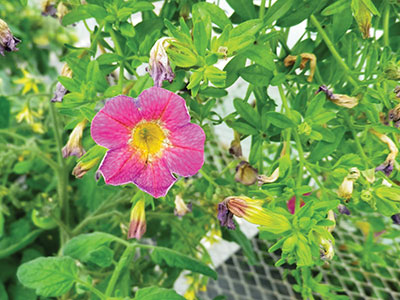
|
Here are a few pictures from a bedding plant grower who called me in early May when greenhouse sales had just begun. This grower was not sure why flower petals on pansy geraniums, some petunias and other plants were turning white with black spots on them. When I looked at the plants, it was very clear the damage was due to thrips. They were loaded inside the flowers of the petunias.
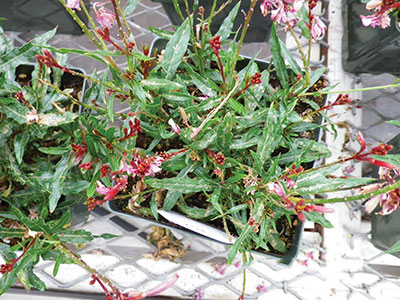
|
|
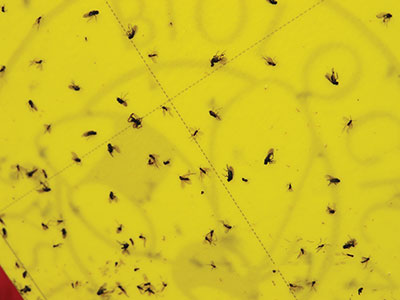 |
The grower had used yellow sticky traps in April. There was evidence of thrips, but there were more fungus gnats around. Thus the presence of thrips was missed early and the appropriate steps could not be taken to control them. The plants had to be removed from the sales area and economic losses were incurred.
Gaining hands-on knowledge is important for growers. These are photos from an IPM workshop held at Thiel’s Greenhouses. Specialists from Koppert Canada, Biobest and The Bug Factory were on hand. Growers learned about the different predators and parasites, and how to introduce them into the crop. Staff from Thiel’s Greenhouses showed how to grow aphid predators on banker plants.
As mentioned earlier, vegetable growers have adapted well to IPM with biocontrols as an important strategy. Bedding plant and ornamental crop growers are increasingly using biocontrols.
More research is needed on integrating the use of dormant oils and other peroxide-based products, which are non-selective in nature.
Here are a few more pictures I’d like to share.
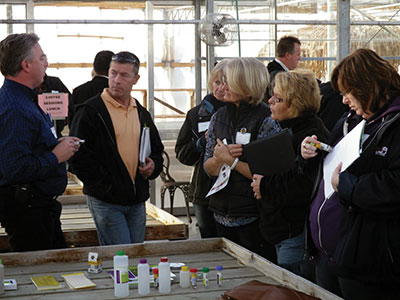 |
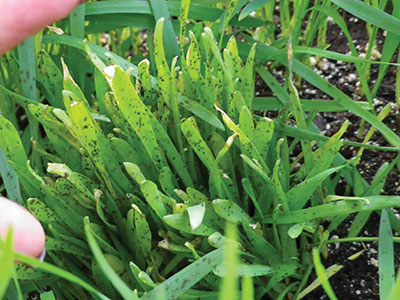
|
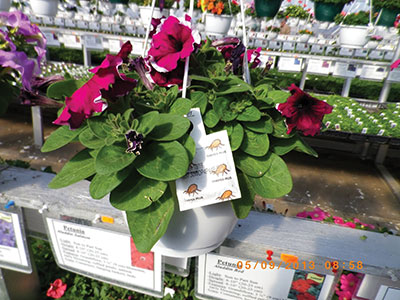 |
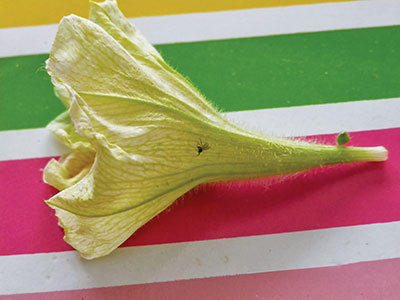
|
I had been following this fungus gnat, which eventually landed on a petunia flower. It got trapped in the flower hairs.
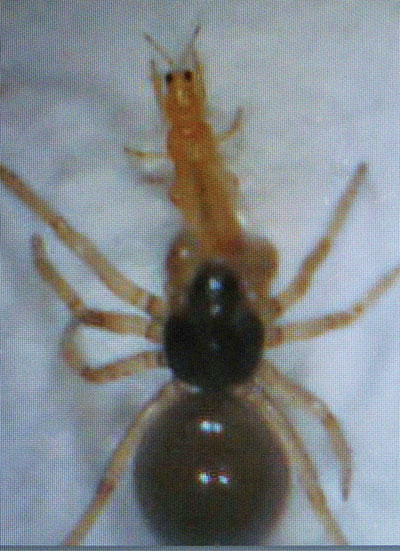
|
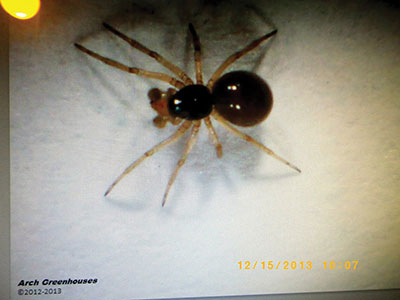 |
Aaron from Arch Greenhouses in Edmonton shared these photos in which a thrip is being eaten by a spider. Watch for good bugs that may be present and doing you a favour. Make them a part of your IPM program!
Dr. Mohyuddin Mirza is a greenhouse consultant. • drmirzaconsultants@gmail.com
Print this page